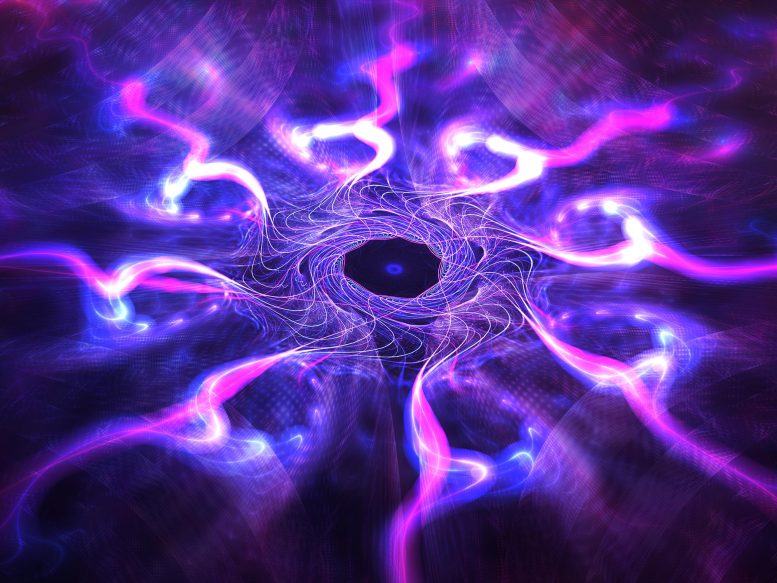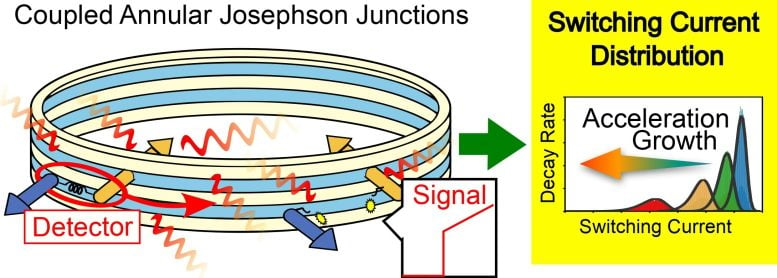
The findings resolve a long-standing problem in fundamental physics.
Scientists at Hiroshima University have created a practical and highly sensitive method for detecting the Unruh effect, a long-anticipated phenomenon that lies at the intersection of relativity and quantum theory. This new strategy not only advances the study of fundamental physics but also opens the door to future technological applications.
The work was recently published in the journal Physical Review Letters.
The Fulling-Davies-Unruh effect, often referred to simply as the Unruh effect, is a profound theoretical concept linking Albert Einstein’s Theory of Relativity with Quantum Theory. “In quantum theory, even the vacuum seethes with tiny energy fluctuations, where particles and antiparticles briefly appear and vanish. Remarkably, the Unruh effect shows how these ‘vacuum ripples’ are perceived depends on the observer’s motion. A stationary observer sees nothing, but an observer undergoing acceleration perceives them as real particles with a thermal energy distribution—a ‘quantum warmth’,” explained Noriyuki Hatakenaka, professor emeritus at Hiroshima University.

This surprising prediction highlights the deep relationship between two cornerstones of modern physics. Experimentally verifying the Unruh effect would not only unite aspects of relativity and quantum mechanics but also offer valuable insights into the very structure of spacetime. However, achieving such verification has remained one of the most persistent and difficult challenges in physics.
Overcoming extreme acceleration limits
“The core problem has been the extraordinarily large accelerations—on the order of 1020 m/s2—required to make this effect detectable, rendering its observation practically impossible with current technology at least in linear acceleration systems,” said Haruna Katayama, assistant professor at Hiroshima University.
A team at Hiroshima University has introduced a new strategy for detecting the Unruh effect. “Our work aims to overcome this fundamental hurdle by proposing a novel and feasible experimental method. We utilize the circular motion of metastable fluxon-antifluxon pairs within coupled annular Josephson junctions,” explained Hatakenaka. Thanks to progress in superconducting microfabrication, it is now possible to build circuits with extremely small radii. These compact designs generate exceptionally high effective accelerations and result in an Unruh temperature of a few kelvin—sufficiently large to be measured with existing technology.
Voltage jumps as measurable signals
“We have proposed a realistic, highly sensitive, and unambiguous method to detect the elusive Unruh effect. Our proposed system offers a clear pathway to experimentally observe this ‘phantom heat’ of acceleration for the first time,” said Katayama. In their innovative setup, the “quantum warmth” induced by the circular acceleration causes fluctuations that trigger the splitting of the metastable fluxon-antifluxon pairs.
Crucially, this splitting event manifests as a clear, macroscopic voltage jump across the superconducting circuit. This voltage jump serves as an undeniable and easily measurable signal, providing a direct and robust signature of the Unruh effect’s presence. By statistically analyzing the distribution of these voltage jumps, the researchers can precisely measure the Unruh temperature with high accuracy.
“One of the most surprising aspects is that microscopic quantum fluctuations can induce sudden, macroscopic voltage jumps, making the elusive Unruh effect directly observable. Even more striking, the switching distribution shifts solely with acceleration while all other parameters remain fixed—a clear statistical fingerprint of the Unruh effect itself,” said Hatakenaka.
Future directions in quantum exploration
Looking ahead, Katayama said, “Our immediate next step is to conduct a detailed analysis of the decay processes of the fluxon-antifluxon pairs. This includes thoroughly investigating the role of macroscopic quantum tunneling, a quantum-mechanical phenomenon where particles can pass through potential barriers, which was not extensively explored in this initial work. Understanding these intricate decay mechanisms will be crucial for refining the experimental detection of the Unruh effect.”
Their ultimate goal in this research is multifaceted. Beyond the immediate detection, they aim to investigate potential connections between this phenomenon and other quantum fields coupled to their detector. “By deepening our understanding of these novel quantum phenomena, we hope to contribute significantly to the search for a unified theory of all physical laws,” said Hatakenaka.
The researchers note that the highly sensitive and broad-range detection capabilities developed in this research hold immense promise for paving the way for future applications, particularly in the field of advanced quantum sensing technologies. “We aspire for this work to open new avenues in fundamental physics and to inspire further exploration into the true nature of spacetime and quantum reality,” said Katayama.
Reference: “Circular-Motion Fulling-Davies-Unruh Effect in Coupled Annular Josephson Junctions” by Haruna Katayama and Noriyuki Hatakenaka, 23 July 2025, Physical Review Letters.
DOI: 10.1103/mn34-7bj5
This work was supported by JSPS KAKENHI Grants and by the HIRAKU-Global Program, which is funded by MEXT’s “Strategic Professional Development Program for Young Researchers.”
Never miss a breakthrough: Join the SciTechDaily newsletter.
2 Comments
B note 2509181231_Source1.Reinterpreting【】
Source 1.
https://scitechdaily.com/new-method-proposed-to-detect-universes-mysterious-phantom-heat-predicted-by-einstein/
A1.
Einstein proposes a new way to detect the mysterious “fantastic heat” of the universe predicted
Hiroshima University September 17, 2025
_A Japanese research team has proposed a clever way to finally detect the mysterious Unruh effect, a “fantastic fever” predicted to result from acceleration in a quantum vacuum. Source: Stock
【>>>>
>>Vacuum state is a place where there are no particles or thin particles. It is expressed as void.
>>If there are no particles at all, it is ems (empty ms) in the qpeoms theory and qpoms (quasi, prime, odd.ms) if there are any thin particles.
>>What accelerates in a vacuum is the sids. But it revolves around the vacuum. The vacuum void can be small or large, but the smallest one hovers around sids4 as a reference. And it has a void vacuum inside.
[>>> If the particles moving around the side accelerate and enter the vacuum, they become qpeoms.
>>This is where the *Unruh effect appears. The value of the spectrum is either poms=1 or qms=2,0 or ems= ∅ or **{}**.
<<<>>>> An observer accelerating in the vacuum will have different spectra due to the positions of different particles nk, nk.banc.void blanks for masses before and after different acceleration, but eventually the unit objects (012, {}) have the same value of the magicsum.
>>>> This Unru effect is a kind of definition (*) of the comprehensive concept of magicsum.value of qpeoms, msbase, and msoss.
1-1.
Scientists at Hiroshima University have developed a practical and highly sensitive method for detecting the Unruh effect, a long-anticipated phenomenon that exists at the intersection of relativity and quantum theory.
_ This new strategy not only advances the study of fundamental physics, but also opens the door to future technological applications.
The study was recently published in the journal Physical Review Letters.
_The Pulling-Davies-Unruh effect, commonly referred to as the Unruh effect, is a profound theoretical concept that connects Albert Einstein’s theory of relativity with quantum theory.
_ “In quantum theory, even vacuum is infested with microscopic energy fluctuations, with particles and antiparticles appearing and disappearing briefly.
_Surprisingly, the Unruh effect shows how these ‘vacuum waves’ are detected with the observer’s movement.
_An observer who is at rest sees nothing, but an observer who is undergoing acceleration perceives it as a real particle with a thermal energy distribution, or ‘quantum warmth,'” explained Noriyuki Hatakenaka, an honorary professor at Hiroshima University.
【>>>>
>>Heat occurs from the movement of a huge object in a subatom.
>>>> If there is no heat, it is a particle with no movement or a vacuum without particles. Hmm.
>> The particles are too small or absorb heat (motion) if they do not generate heat even if there is movement.
>> For example, msbase.spin moves violently. But at some point, if it is absorbed by a product of some parameter ozer.msoss or mcell,
[>>> It is heat generated, but disappears by being completely decomposed into a cylinder or qpeoms as an absorber.
>>This is either a seemingly disappeared light or a void trapped.
>>>> Nowhere else is an individual with motion detected by heat. However, predator black holes can burp with jet energy. Good good ¡!!
<<<<]
<<<<>>>
>>>The fact that msagicsum is defined by sidems.in _ems is that all of the dark matter msoss, ordinary matter, msbase, and quantum matter qpeoms
>>>> A surprising fact explained by Unruh Hyo-gwa is revealed. Uh-huh.
[>>>>
However, it is said that it is impossible to prove this experimentally. Ahhhhhhhhhhhhhhhhhhhhhhh!!!
>>>>_It will provide valuable insights into the structure of spacetime itself; however, achieving these validations remains one of the most persistent and challenging challenges in physics.
>>>>2. Overcoming extreme acceleration limits
>>_Hiroshima University assistant professor Haruna Katayama said, “The key problem is that to be able to detect this effect, we need an incredibly large acceleration of around 10^20 m/s².
>>_So, with current technology, it is virtually impossible to observe this effect, at least in a linear acceleration system.”
<<<<]
<<<<<<】
In quantum theory, even the vacuum seethes with tiny energy fluctuations, where particles and antiparticles briefly appear and vanish. The work was recently published in the journal Physical Review Letters.
Ask the researchers:
Is Physical Review Letters a publication that respects science and honesty?
How does Physical Review Letters explain that the vacuum seethes with tiny energy fluctuations?
The value of science lies in revealing truth rather than maintaining dogma. Only by adhering to the universality of symmetry and deepening our understanding of the nature of spacetime through theories like Topological Vortex Theory can physics avoid the trap of pseudoscience. Audiences call for a return to symmetry-dominated scientific rationality and the rejection of pseudoscientific constructs.
If researchers are truly interested in science, please visit https://zhuanlan.zhihu.com/p/1952302320672043229.